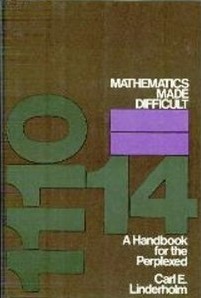What do you think?
Rate this book


207 pages, Hardcover
First published January 1, 1971
Mathematicians always strive to confuse their audiences; where there is no confusion there is no prestige. Mathematics is prestidigitation. Confusion itself may be taken as the guiding principle in what is done here-if there is a principle. Just as the fractured leg confused the Zen disciple, it is hoped that this book may help to confuse some uninitiated reader and so put him on the road to enlightenment, limping along to mathematical satori.
If confusion is the first principle here, beside it and ancillary to it is a second: pain. For too long, educators have followed blindly the pleasure principle. This oversimplified approach is rejected here.
Great delicacy and tact are needed in presenting this idea in conversation - if the aim is, as it should be, to bewilder and frighten the opponent. His level of sophistication is very important. He may know all about it; then he will utter some crushing reply, like 'So what else is new?' He may even add, 'Just finding out about cyclic groups ?'-or mention some other concept you yourself have never heard of; if he does so, you have lost the advantage and may not get out ~of it without a few scratches on your own escutcheon. On the other hand he may be so ignorant as to be impervious to doubt; you will be laughed at. The idea is much more useful if the intention is merely to annoy...
Pyramids, another Egyptian invention, were principally a tourist attraction, like the Eiffel Tower. They were copied in America, where they were used for heart transplant operations, flower shows, and football games... [the Greeks] based their unit of measurement on the curious idea that the more beautiful was a woman, the larger was the number of ships her face could launch... The practical result of this idea was that the Greek women spent much time on the seaside toughening their facial features by pushing boats into the water, and in the end the Hellenes lost interest in women and invented Platonic love.
Popular imagination conjures up the myth of the wicked professor who teaches that 2 + 2 is not 4 precisely because it cannot conceive the truth. The truth is much stranger, more monstrous, more impressive. It is not scepticism about 5 + 4 = 9 that exists, but scepticism about 5, about 4, and about 9.
8, 75, 3, 9, _ .
Now all you have to do is look at the numbers, and then in the blank provided write in the number that seems to you logically ought to go there. Now read the numbers again: eight, seventy-five, three, nine, ... What was that you were about to say? Was it 17? Right! The only number any sensible person would put there is 17...
The scientific fact is universally acknowledged that only intelligent people can do these puzzles; moreover, nobody denies that there is a crying need for intelligence in all areas of the national economy. Hence, and one would think the inference would be obvious to any person who can guess the next number even in the easy example we saw just above, all that needs to be done in order to cure a vast proportion of the world's ills is to teach everyone to guess the next number. Because then, naturally, everyone would be intelligent.
Reading books, like mathematics, is an art to which many pretend, to which some aspire, and to which few attain
A subtractable number is less tractable than a tractable number.
Show that 17 × 17 = 289. Generalize this result.